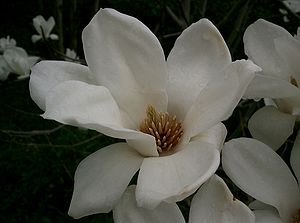Yulan magnolia
| Yulan magnolia | ||||||||||||
|---|---|---|---|---|---|---|---|---|---|---|---|---|

Yulan's magnolia blossom ( Magnolia denudata ) |
||||||||||||
| Systematics | ||||||||||||
|
||||||||||||
| Scientific name | ||||||||||||
| Magnolia denudata | ||||||||||||
| Desr. |
The Magnolia Denudata ( Magnolia denudata ) is a plant from the genus of Magnolia ( Magnolia ) within the family of the Magnoliaceae (Magnoliaceae). She comes from eastern China. It is used as an ornamental wood in the temperate areas of the world; It gained special importance as a parent of the well-known tulip magnolia .
description
Vegetative characteristics
The yulan magnolia is a deciduous, deciduous tree that reaches heights of 15 to 20 meters. The crown is often broad and multi-stemmed. The gray bark remains smooth even on thicker trunks. The bark of the branches is dark brown and initially hairy. The buds are hairy.
The alternate leaves are divided into a petiole and a leaf blade. The petiole measures 2 to 3 centimeters. The simple leaf blade is 8 to 15 centimeters long and 5 to 10 centimeters wide and elliptical with a wedge-shaped blade base and a pointed upper end. The upper side of the leaf is fresh green in color and smooth and the underside is light green and initially hairy.
Generative characteristics
The slightly fragrant flowers that appear before the leaves shoot are individually at the ends of the branches and are 10 to 20 centimeters wide. A single flower consists of nine (occasionally ten to twelve) white tepals , which are sometimes pink in color at the base or on the midrib. In the center there are numerous pink to purple stamens and numerous greenish-white pistils .
The cylindrical, 5 to 15 centimeter long pelvis fruit is first green and later turns pinkish-red. The seeds are surrounded by a red seed coat ( arillus ).
The Yulan magnolia is hexaploid and the number of chromosomes is 6n = 114.
Occurrence
The yulan magnolia is found in the east and south of China. It can be found from southeastern Jiangsu and Zhejiang , through southern Anhui to southwestern Hunan , Guangdong and Fujian . The climate is temperate and humid, the soils are humic and have a slightly acidic pH. However, since their habitat has been used by humans for a very long time, the original area is difficult to determine. Some occurrences could also come from planted specimens.
use
The yulan magnolia has long been planted as an ornamental tree in China. The white flowers symbolize purity, which is why it was often used near temples. It is often depicted on works of art, its flowers are eaten, and the bark is used as medicine.
It is used as an ornamental plant, but its flowers are quite often destroyed by late frosts in Central Europe. It is therefore more important as a parent of the tulip magnolia ( Magnolia × soulangeana ), a cross between the yulan and purple magnolia ( Magnolia liliiflora ). Hybrids of the Yulan magnolia with Magnolia campbellii are known as Magnolia × veitchii , but these large, early-flowering trees are rare in trade. Crosses with the cucumber magnolia were carried out to obtain yellow blooming magnolias. Crosses were also successfully carried out with other magnolias from the Yulania section . Some varieties of the Yulan magnolia have been selected, for example 'Caerhays Clone' (1973), 'Globosa' (1915) or 'Wada's Japanese Clone'.
Systematics and botanical history
Within the genus Magnolia , the Yulan magnolia is classified in the sub-genus Yulania , there in the section and subsection Yulania . Related species are, for example, Magnolia campbellii , Magnolia dawsoniana or Magnolia sargentiana .
Engelbert Kaempfer published a description of the Yulan magnolia as early as 1712 , which was reissued by Joseph Banks in 1791 . The images of the yulan and purple magnolias were labeled “Mokkwuren” - the Japanese name for magnolias, as Kaempfer got to know the plants in Japan. Desrousseaux then described the plants shown scientifically and chose the name Magnolia denudata , the "naked magnolia", because the flowers appear on the bare branches in spring. However, Banks had swapped the signatures under Kaempfer's pictures, so that Desrousseaux confused the descriptions of Yulan magnolia and purple magnolia. Pierre Joseph Buc'hoz also only described these two magnolias using illustrations in 1779; three years earlier he had published an illustrated book with Chinese motifs. He named the Yulan magnolia Lassonia heptapeta . In contrast to Kaempfer's botanically correct illustrations, these were “obviously Chinese impressionist art”. James Edgar Dandy transferred this name to the genus Magnolia in 1934 , i.e. as Magnolia heptapeta , but from 1950 only as a synonym for Magnolia denudata . However, Spongberg and other authors used heptapeta again from 1976 until Meyer and McClintock highlighted the numerous errors in Buc'hoz pictures in 1987 and suggested the use of the name Magnolia denudata , which is still used today , with Kaemmer's illustration as a type.
Individual evidence
- ↑ Rafaël Govaerts (ed.): Magnolia denudata. In: World Checklist of Selected Plant Families (WCSP) - The Board of Trustees of the Royal Botanic Gardens, Kew . Retrieved September 25, 2019.
- ↑ D. Cicuzza, A. Newton, S. Oldfield: The Red List of Magnoliaceae. Fauna & Flora International, Cambridge UK 2007, ISBN 1-903703-23-9 , p. 22. ( digitized version )
- ^ Magnolia Society International: Classification of Magnoliaceae. 2012. Adapted from: Figlar & Nooteboom: Notes on Magnoliaceae. Volume IV. 2004.
- ↑ Callaway 1994, p. 136
literature
- DJ Callaway: The World of Magnolias. Timber Press, Portland Oh 1994, pp. 135ff. ISBN 0-88192-236-6


